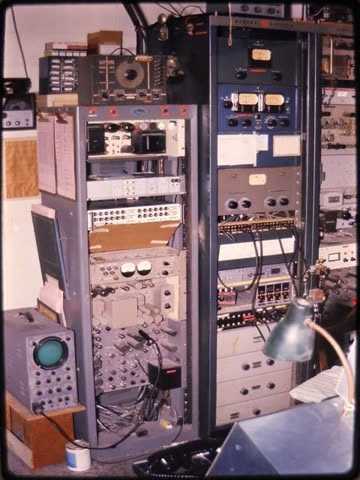 Equipment racks containing the microwave receivers, demodulator for audio
and video, audio and video pre processing, video stabilization amplifiers,
etc.
Equipment racks containing the microwave receivers, demodulator for audio
and video, audio and video pre processing, video stabilization amplifiers,
etc.
The photos were all taken by me except for one, which is noted.
Camera used was a Yashica SLR 35 mm usually with Ektachrome 64 slide film.
The slides were converted to digital using a Nikon L16 camera on a stand over a light box.
 The next nine pictures were taken at the WSIL - TV transmitter site near
Creal Springs, Illinois.
The next nine pictures were taken at the WSIL - TV transmitter site near
Creal Springs, Illinois.
March 1977
This General Electric television transmitter is a model TT-40-A built in 1946. It operated on channel 3. The final amplifiers for both Aural and Visual each used a single water cooled triode tube.
Note the bluish glow from the mercury vapor rectifiers seen through the window below the 'General Electric' logo.
 Equipment racks containing the microwave receivers, demodulator for audio
and video, audio and video pre processing, video stabilization amplifiers,
etc.
Equipment racks containing the microwave receivers, demodulator for audio
and video, audio and video pre processing, video stabilization amplifiers,
etc.
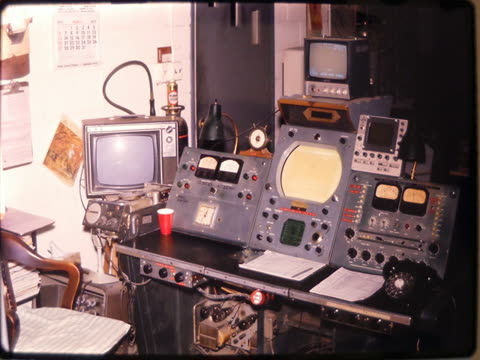 This is the original GE operating console. The TV set on the left was our
'color monitor' and the instrument just to the right and above the old GE
video monitor is a Tektronix 1480 waveform monitor.
This is the original GE operating console. The TV set on the left was our
'color monitor' and the instrument just to the right and above the old GE
video monitor is a Tektronix 1480 waveform monitor.
The FCC had not required too many modifications from the original
equipment.
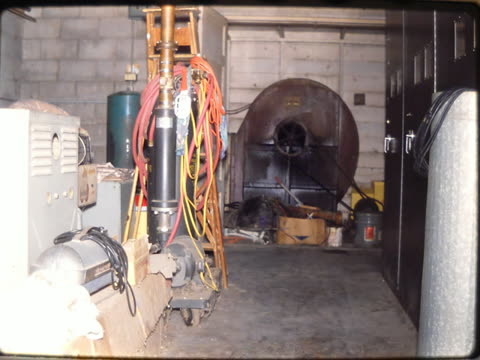 This is the space in the building behind the large transmitter.
This is the space in the building behind the large transmitter.
The white louvered cabinet at far left contains the high voltage power
transformer.
The green vertical tank is the pressure tank for the well water.
The vertical device on the dollies is a calorimeter / dummy load.
The brown oval at the rear is the large squirrel caged exhaust fan for
building cooling.
The rear of the transmitter is at far right.
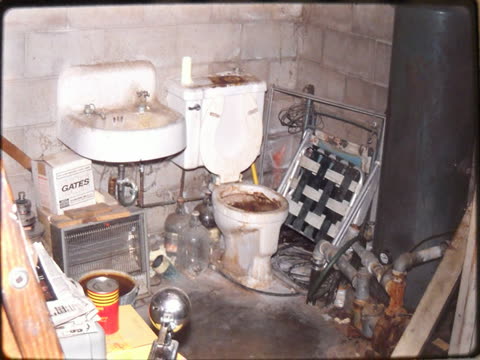 The bathroom!
The bathroom!
The well water was non-potable, as it was high in various mineral content,
and would leave nasty stains on all it touched. Due to the high voltage
conductors in cable troughs in the floor, we only ran the well pump after
sign-off for fear of a spill. The danger to life, and probable damage to
equipment was not worth the risk of having this water on demand. After
sign-off, the transmitter operator would fill a large bucked to be used to
flush the toilet during the next day.
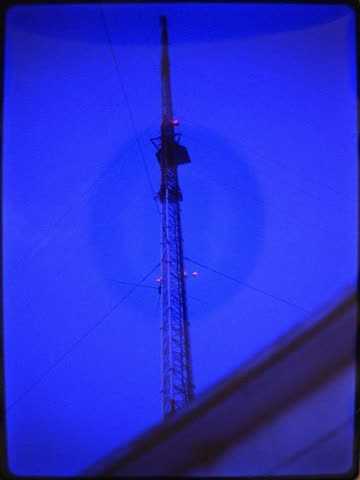 The 900 foot tower as seen against the late evening sky. The 'flyswatter'
a ways up, reflected to a microwave dish antenna on the ground at tower
base.
The 900 foot tower as seen against the late evening sky. The 'flyswatter'
a ways up, reflected to a microwave dish antenna on the ground at tower
base.
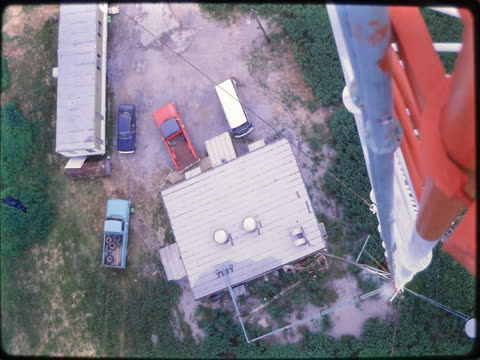 The view down from approximately 350 feet up on the tower at the location
of the 2 Ghz microwave antenna.
The view down from approximately 350 feet up on the tower at the location
of the 2 Ghz microwave antenna.
The small gray circle at extreme right, bottom, is the radome over the ground mounted 7 Ghz dish which is fed via the reflector / 'flyswatter' a little higher up the tower.
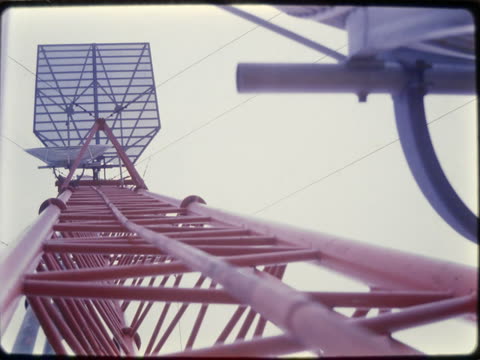 Looking up towards the 'flyswatter' and another microwave dish.
Looking up towards the 'flyswatter' and another microwave dish.
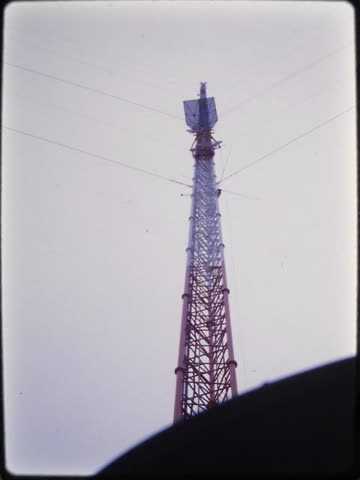 Looking up the tower from near the transmitter building.
Looking up the tower from near the transmitter building.
The next seven pictures where taken at the 'Pine Bluffs' microwave site during the installation of a new 10 foot dish antenna during the summer of 1980. This site was one of nine microwave relay sites used to bring television programming from Denver, Colorado to Rapid City, South Dakota.
The 'Pine Bluffs' site is in Nebraska, southeast of Pine Bluffs, Wyoming, near the Colorado border.
After waiting several days for the 30 mph plus wind to go down we decided on plan 'B'. That plan was to rig the tower with two trolley lines from the top of the tower, to ground embedded anchors, and on to truck mounted winches. The dish was fastened to these lines at each side, and the winches kept the trolley lines taught so the wind could not move it in any direction.
The tower crew was that of Paul Betzing of Souix Falls, South Dakota.
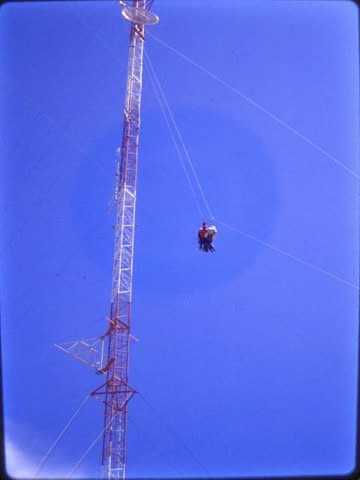 A crew member riding a piece of hardware from the top of the tower down.
A crew member riding a piece of hardware from the top of the tower down.
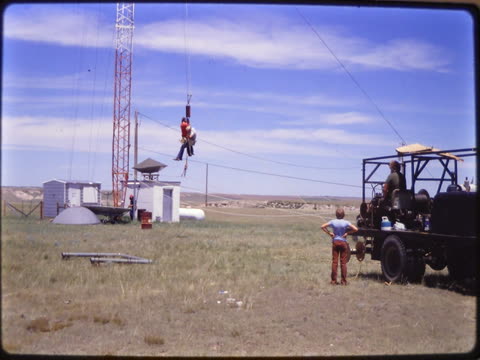 Same as above, nearly ready to land.
Same as above, nearly ready to land.
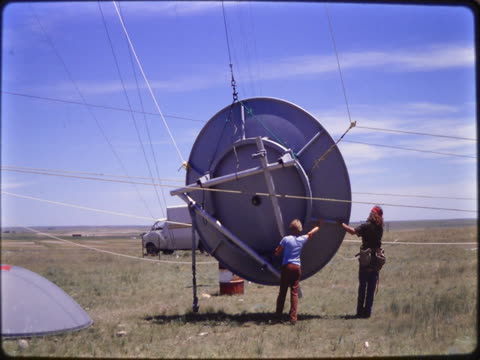 The dish as fastened into the trolley system.
The dish as fastened into the trolley system.
The man at right is Paul Betzing and the kid to his left is his son
'Paulie' at 12 years old. 'Paulie' went everywhere on any tower, and was
surely the youngest tower crew member anywhere.
'Paulie', Paul Jr., later on, took over the company after his father's death.
 Paul and the dish start the journey upwards.
Paul and the dish start the journey upwards.
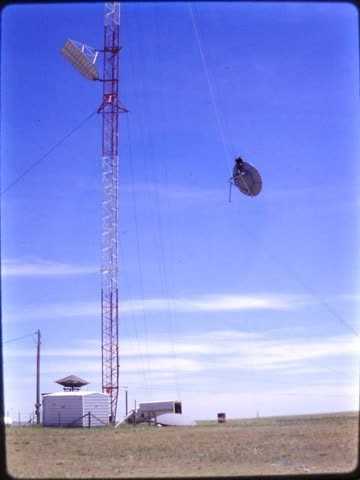 Less than halfway.
Less than halfway.
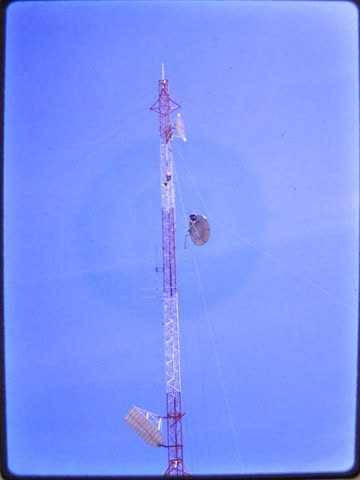 This is almost to the location on the tower where the dish will be
installed.
This is almost to the location on the tower where the dish will be
installed.
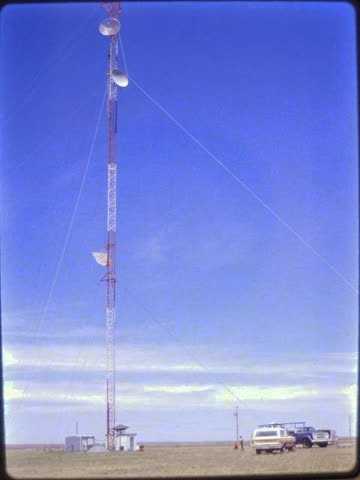 The dish will be bolted onto the tower at this location.
The dish will be bolted onto the tower at this location.
A hand winch is used to pull the dish to the tower, against the tension of
the trolley lines.
Due to the wind, we would not have been able to install this antenna except
for the winch truck with the three winches and the many extra feet of steel
cable.
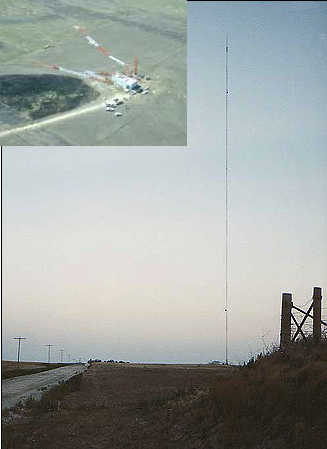 This photo was not taken by me. It was E-Mailed to me, and I do not know
who was the photographer.
This photo was not taken by me. It was E-Mailed to me, and I do not know
who was the photographer.
It is a picture of the 1,976 foot tall KDUH - TV tower near Hemingford,
Nebraska.
The photo inset is the tower after it collapsed during maintenance on
September 24th, 2002, killing two of the tower crew, injuring three people
on the ground, destroying the transmitter building and contents, crushing
several vehicles, and setting a grass fire.
A new tower has since been built near Angora, Nebraska.
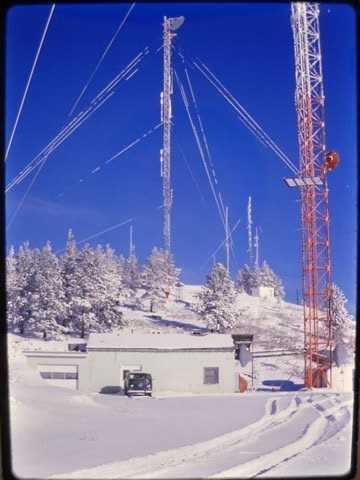 This is the KHSD - TV transmitter site at Terry Peak, near Lead, South
Dakota, in November 1979.
This is the KHSD - TV transmitter site at Terry Peak, near Lead, South
Dakota, in November 1979.
The KHSD - TV tower is at right.
The tower at center rear belonged to the State of South Dakota.